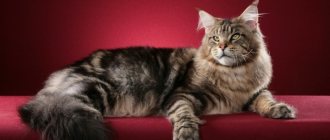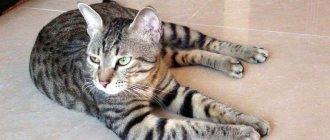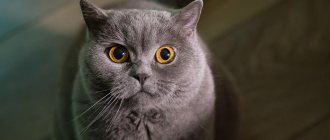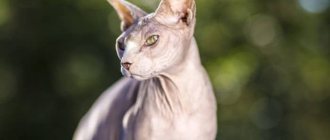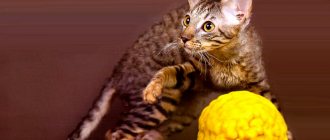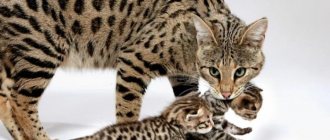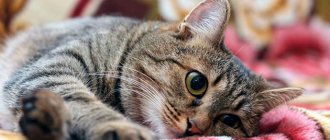Origin story
The first name for Chantilly Tiffany cats is foreign longhair.
It is unknown how their descendants appeared, but one thing was found out for sure - the descendants of these cats were Asian Longhair and Burmese. In 1967, breeder Jenny Robinson bought a pair of “chocolate” cats: Thomas and Shirley. A couple of years later they had offspring: equally beautiful kittens with bright eyes. Jenny immediately realized that these babies were a real treasure and began breeding the breed. Sinjin Lund, a felinologist who has been studying Burmese cats for many years, helped her with this.
Lund bought all the offspring and brought a couple of individuals to a major New York exhibition. The cats were highly rated, but they didn’t like the name of the breed – “foreign longhair”, and the similarity with the Burmese seemed too close to the experts.
For a long time the matter did not move forward. Kittens were born one by one, but the breed received recognition only in the early 90s of the twentieth century: when other breeders - Jan Deregti and Tracy Oraas from Canada - “added” Somali cats, Nibelungs, Havana Browns and Turkish Angoras to the breed.
The breed received the name “Chantilly Tiffany” to avoid confusion: at that time the Tiffany breed had just appeared in Britain.
Unfortunately, the number of nurseries has decreased over time, not increased: in 2011 there were 6 in North America, in 2003 - 1. In 2011, it burned down. All representatives of the breed died in the fire, with the exception of Frosty the cat. He was transported to a Norwegian nursery, where the last Chantilly Tiffany cat, Acie, was born.
At the moment there are no nurseries, but you can buy such a cat from private breeders.
Feeding
Remember that domestic cats are very prone to obesity and overeating, so you need to carefully monitor the frequency of meals, which should not exceed 2 times a day. Choose food that your pet likes.
Be sure to make sure that the food is appropriate for the kitten’s age, which will allow you not to worry whether your pet is getting enough to eat or not. Some breeders claim that cats eat dry food just fine, others say that natural food is preferable. It should be remembered that with completely natural food, it is necessary to periodically introduce vitamins, microelements, and plant fibers into the diet in the form of raw grass or a special supplement from a veterinary pharmacy.
The basis of the diet during natural feeding should be lean meat, sea fish, and eggs. It is necessary to dilute the menu with porridges, for example, buckwheat, barley, and vegetables (zucchini, carrots). Avoid giving cats starchy vegetables such as potatoes, green peas, and boiled beets. Chantilly-Tiffany's favorite treat is fruit.
Standards
The average weight of males is 4-5, rarely 6 kg. Females weigh 1-1.5 kg less.
| Standard | Description |
| Head | Wedge-shaped, with smoothed features, small. The cheeks are small, the chin is medium size, strong. The forehead is wide and sloping. The whisker pads are round and clearly drawn. The nose is neat, with a small “stop” on the bridge of the nose. The eyebrows (like the mustache) are lush and large. |
| Ears | Large, widely spaced, abundantly pubescent both inside and outside. |
| Eyes | Almond-shaped, the color of the iris is all shades of yellow. |
| Frame | Small, graceful, with well-developed muscles. The limbs are slender, with oval, densely pubescent paws and small, but sharp, claws. |
| Tail | Long, with a sharp tip. Abundantly pubescent. |
| Wool | So thick and long that it gives the animal massiveness and significantly increases its size. The fur is soft, velvety to the touch, does not stick together and practically does not get dirty. Sheds little. |
Significant disadvantages:
- Different color;
- The eyes are green;
- Short hair on the body;
- White medallions;
- Lack of fluffy “pants” and “collar”.
Requirements for appearance and color and photo
Cats of this breed have a slender and elegant build. The body and paws are strong and muscular, but due to the abundant fur they do not look massive. A characteristic feature is the almost identical length of the body and tail. The latter should be straight, slightly rounded at the end. The presence of a plume (flowing fur resembling a feather) is mandatory.
The head is wedge-shaped. The muzzle is quite wide. But the fluffy wool collar around the neck makes it seem smaller than it actually is. The eyes must be a bright amber color. Other shades are not acceptable. Animals' ears are always set wide apart and slightly tilted forward. Excessive fur is not considered a fault. Chantilly paws look elegant. Their tips are very neat and rounded. According to the standard, fluffy panties should be present on the hind legs.
The coat is always thin and silky, without undercoat. At first, the standard allowed only one color option - chocolate. Other options are now available:
- solid (all shades of chocolate);
- silver and smoky shaded;
- tabby (all 4 types).
The full color appears only in the second year of life.
Character and behavior
A furry weasel is what breeders kindly call Chantilly Tiffany. This breed is ideal for indoor keeping. Once in your house, the animal will quickly choose one person - its favorite one - and will constantly follow him like a little dog, waking him up in the morning and waiting near the front door after work. And, by the way, under the toilet door too.
It is communication with a person that Chantilly gives preference to. They are soft and reserved, are not afraid of strangers, willingly go to meet guests, but do not allow liberties with themselves. They are easily frightened: if a guest makes a sharp gesture or raises his voice, they quickly retreat to a secluded corner and watch the further development of events from there.
Restraint is another of their distinguishing features, but they also do not shy away from games. Especially if their beloved owner or other pets (with which, by the way, these cats get along very well) will participate.
Chantillies are smart and grasp information on the fly, so they are easy to teach tricks and commands. They look at new objects with interest, and if the owner teaches them through play, then the process will be fun and easy.
They quickly adapt to new places and conditions. But they cannot stand loneliness. This is a real punishment for them! If Chantilly is left alone often and for a long time, she will get sick more often and gradually turn into a real savage.
The cat loves to walk in the fresh air, but letting her go out on her own is very dangerous. A friendly Chantilly Tiffany can be suitable for acquaintance not only with a cat, but also with a dog that can show aggression.
And there are many other dangers lurking for a cat: cars, poisons, and cold. And fleas and ticks brought into the house are unlikely to bring you much joy.
Chantilly Tiffany are more talkers than silent ones. If you prefer quiet, they are not for you.
Chantilly - especially at a young age - are very curious creatures. By trying to stick their nose into all the corners and pots, kids can get an electric shock, burn or other injury, so take precautions in advance: hide all wires away, put special nets on the windows, remove toxic plants, sharp and breakable objects.
Breeding Chantilly-Tiffany
Since the Chantilly Tiffany is officially considered an extinct breed and very few enthusiasts breed it, it will be extremely difficult to get two kittens of different sexes and not related. Especially considering the price of kittens, which starts at $700.
You can only buy Chantilly abroad. This is easiest to do in America, Great Britain or Scandinavia. If you buy kittens for breeding, make sure they meet the standard.
Chantilly Tiffany is difficult to find and buy
Breeding Chantilly Tiffanys is no different from breeding other cats. It is even easier to do this, since you do not need to register cats in the club, participate in exhibitions and fight for the right to breed (title page or breeding assessments). It is advisable that the person who undertakes the breeding of Chantilly already has experience in breeding cats. Ideally, have your own small nursery.
There are no pitfalls in breeding Chantilly - they are not susceptible to hereditary and genetic diseases, and childbirth usually occurs without complications. The main thing is to follow the correct regime and monitor the health of your pets.
Breeding Chantilly-Tiffany can only be entrusted to an experienced person
How to choose the right Chantilly-Tiffany kitten and not end up with an outbred “Murzik”:
- the kitten's coat should be fluffy and slightly tousled, soft and silky, without undercoat;
- color is uneven, but without white markings;
- legs are not long;
- the kittens themselves are stocky and tightly built, with a rounded chest and wide back;
- the head is rounded, with smooth contours, the muzzle is short, but not flattened;
- ears are large and pointed;
- the eyes are slightly bulging and large;
- The kitten must meet the color standard.
Chantilly Tiffany kittens cannot be confused with any other breed
Also pay attention to the baby’s health:
- his eyes should not water, his ears and nose should not fester;
- the cub must be active, fearless and curious;
- the tummy is not inflated and not hard, but soft and not protruding;
- the cub is moderately well-fed: the bones do not protrude, but are easily palpable;
- the fur is shiny and clean, well-groomed;
- the area under the tail is clean, the anus is not inflamed;
- there are no scratches or wounds on the skin;
- the baby's gait is natural;
- there is no unpleasant odor coming from the mouth;
- The teeth are white and clean, the gums and mucous membranes are pinkish, not red or bluish.
You don't see Chantilly Tiffany very often - breeders have little interest in restoring old breeds. And in vain, since Chantilly is a real standard of feline grace, royalty and elegance. If you are lucky enough to become the owner of this chocolate beauty, then you will acquire the most faithful, slightly capricious, but loving and affectionate friend.
Care instructions
Wool
The Chantilly does not have a thick undercoat, so this breed does not require daily brushing. 1-2 times a week is enough. Brush – only a special one: metal, with rounded teeth (or a rubber glove).
Bathing
Clean cats are good at taking care of themselves, but they still need to be washed from time to time. Not too often (frequent bathing washes off the protective layer and causes skin irritation) - once every 3-4 months and, of course, before the exhibition. But it should be borne in mind that representatives of the Chantilly Tiffany breed categorically do not like to swim: they break out, squeak indignantly and express their dissatisfaction in every possible way. Therefore, it is advisable to enlist the support of an assistant who will hold the animal.
Does your cat like to swim?
Not really
Make sure that water and detergent do not get into your cat's ears or eyes. You can insert cotton swabs into your ears and put a rubber cap on your head. Use only special products for cats (semi-long and long hair). After bathing, gently dry the coat with a towel, but do not rub too hard, otherwise it will become tangled.
Eyes
Inspect your eyes daily; if necessary, wipe off discharge with a cotton swab dipped in chlorhexidine or warm boiled water. It is not recommended to use tea leaves or chamomile infusion: Chantilly wool may take on an unnatural shade.
Ears
The ears are inspected and cleaned weekly using a cotton swab dipped in ear lotion or chlorhexidine.
Teeth
Teeth are brushed once a week using a special toothbrush and toothpaste (Beaphar, Trixie, Cliny).
There are a huge number of cleaning products in veterinary pharmacies and pet stores. Therapeutic, preventive, refreshing, with the taste of mint, fish or meat, with bone meal, specialized tooth powder, special pads...
If your pet meekly allows you to brush its teeth, the problem is easily solved, but what if not? You will have to take him to the veterinarian every year for laser cleaning, and at home you will have to drip gum-cleaning gel into the drinking water.
Expert opinion
Dusheba Vera Ivanovna
In 2010, she graduated from the Moscow State Academy of Veterinary Medicine named after K.I. Scriabin with honors, specializing in veterinary medicine. I regularly attend veterinary conferences, congresses, and webinars.
If your cat's gums turn red and begin to bleed, there is an unpleasant smell from the mouth, hard, yellowish formations appear on the teeth, and there is swelling on the gums - show the animal to the veterinarian.
Claws
Nails are trimmed once a month using nail clippers or a special nail clipper. Be careful to trim the very tip of the nail, being careful not to catch the vessel at the core.
Pictured are kittens of the Chantilly Tiffany breed
Health and illness
https://www.youtube.com/watch?v=fQOdmglR0ks
The Chantilly Tiffany is a cat with good health. She did not inherit any diseases from her ancestors, so her body is extremely rarely affected by congenital and acquired pathologies. In addition, Chantilly has strong immunity, so they do not suffer from viral diseases. The most common problems are with weight and with the nervous system.
Obesity
Symptoms of obesity in a cat:
- The cat's weight is 20% or more higher than normal.
- Severe shortness of breath with little activity.
- Mobility problems.
- Inability to feel the ribs or spine through the fat layer.
What causes obesity:
- Genetic predisposition.
- Uncontrolled eating.
- Hormonal disbalance.
- Lack of sufficient physical activity.
Obesity is much easier to prevent than to cure. To do this, the cat needs to ensure maximum physical activity and proper, balanced feeding, as well as suppress any attempts to steal food or begging. But if the cat has gained excess weight, then treatment involves diet, physical activity and, if necessary, taking hormonal medications.
Obesity causes many problems for cats: diabetes, joint diseases, disorders of the cardiovascular system and much more.
Obsessive-compulsive neuroses are nothing more than a protective reaction of the cat’s nervous system to stress. It is designed to distract her from an unpleasant situation. The main symptom is that the cat grooms itself for too long and thoroughly, sometimes until bald spots form. In constant stressful situations, this becomes a habit, and eventually such a reaction occurs even to the most insignificant stimuli.
Other symptoms of neurosis:
- Fixed gaze, hunting for imaginary prey, clicking teeth, beating the air with paws.
- Excessive consumption of food and (or) water, excessive salivation, “sucking” of wool and other materials.
- Tail wagging, head shaking, jumping into the air for no reason, increased motor activity, increased sensitivity to cold.
- Frequent meowing.
- Biting paws or tail, causeless aggression towards people.
Treatment of neurosis is long and labor-intensive and is based on minimizing stressful situations and a certain technique for correcting behavior and getting rid of neurotic habits.
One of the symptoms of neurosis is constant licking
Catering
Representatives of this breed tend to gain excess weight, and in a fairly short period of time. Therefore, you must strictly adhere to the recommended proportions and not follow the lead of your pet, who touchingly looks into your eyes and begs for another tasty morsel.
Chantilly Tiffany are amazingly capable actors. If they notice that you reacted positively to their plaintive cries and body movements, they will organize a concert over and over again.
The feeding rules are:
- Adults (over 6 months) should be fed 2 times a day: morning and evening. After eating, bowls should be washed thoroughly (without using chemical detergents). If a cat smells the stench of spoiled food, it will refuse to eat from this dish. Babies are fed 3-6 times a day: the younger the kitten, the more often feedings are carried out. Exceptions also include pregnant and lactating, exhausted and sick animals. Their menu and feeding schedule are discussed with the veterinarian.
- You cannot mix ready-made food and food prepared by yourself. To digest both the first and second, different enzymes are required.
- Clean water at a comfortable temperature (not hot, but not from the refrigerator) should be present in the drinking bowl at all times! Do not feed your cat liquid from the tap: it contains too much chlorine, iron and salts harmful to the animal. A household filter can remove them. You can settle the water (10-12 hours in a dark place, without covering the container with a lid) or buy bottled water.
Natural products
The menu should contain the following products:
- Meat is of good quality and low-fat varieties. These are beef, veal, rabbit, turkey, lamb. The meat is not boiled, much less fried, but pre-frozen in the freezer for a day or two. Before feeding, defrost, pour over boiling water and cut into small pieces. A kitten needs 30 grams per day, an adult cat needs 100-120 grams.
- By-products: liver, stomachs, hearts, kidneys. They can be given raw (except for the liver: it is too heavy for the stomach) or boiled. It is better to grind chicken necks into minced meat.
- Fish: salmon, rainbow trout, cod, chum salmon, halibut, pink salmon, flounder, sardine, tuna. All fins and sharp parts must be cut off from the fish, scales and bones must be removed. You can feed it either raw or boiled (without salt or seasonings). You cannot constantly feed Chantilly Tiffany with fish: the animal’s thyroid function and metabolic processes are disrupted, iron is poorly absorbed, and urolithiasis develops.
- Rice, buckwheat, oatmeal, barley, millet porridge. They are boiled in water; you can add just a little milk for taste. Children cook semolina porridge by adding a drop of honey.
- Fresh or boiled milk is given to kittens up to 3 months. In adult cats, it often causes digestive upset, but if your pet loves it and does not have stomach problems, you can leave the product.
- Boiled chicken yolk (pure or mashed with milk, kefir, yogurt). Give 1-2 times a week.
- Fermented milk products: fermented baked milk, kefir, cream (10%), yogurt, low-fat cottage cheese, natural yogurt, sour cream, unsalted hard cheese. Can be given every day.
- Boiled quail eggs – 3-4 times a week.
- Raw or cooked vegetables: pumpkin, carrots, zucchini, green beans, broccoli, cauliflower, greens (dill, parsley, spinach, lettuce).
- Dry brewer's yeast - 3-4 times a week.
- Vegetable oil: olive, sunflower, flaxseed – half a teaspoon per porridge.
- Vitamins.
To cleanse the stomach of cats, they grow wheat, barley or oats. The animal will nibble on green sprouts at will.
Your cat should always have fresh water, free of chlorine and harmful impurities, at a comfortable temperature. Water can be bought in a store, purified through a regular filter, or left to stand for a day.
It is prohibited to give:
- Pork, duck meat, goose meat, lamb (the body does not digest fatty meat well, in addition, the meat of these birds is often infected with worms);
- Rotten, smelly meat;
- Bones (a cat might choke), tripe, lard;
- Butter;
- Sweets: candies, pastries, cakes, marmalade, marshmallows, marshmallows, sugar, chocolate (chocolate is poison for cats, other foods are poorly digestible and disrupt metabolism);
- Salt, spices, seasonings (not absorbed by the body);
- Human canned food, sausages, sausages, smoked, dried, fried, spicy, fatty foods (disturb metabolism);
- Beans, peas, chickpeas, soybeans, potatoes, tomatoes, eggplants (not digestible, cause stomach upset);
- Vitamins and medicines for people (can cause severe poisoning, even death);
- Dog food (not digestible).
Recommended food
Ready-made foods are convenient and easy to buy (or order online). There are many different lines for animals of all ages, in addition, the presence of chronic diseases and the characteristics of a particular animal are taken into account (for example, for cats with long hair, with a sensitive stomach, etc.).
Cat foods of the economy and premium classes are significantly cheaper than foods of the super-premium and holistic classes, but they also differ greatly in quality.
Firstly, there is practically no pure meat in them (or none at all), and the combination “meat waste” hides food production waste: ground bones, skin and feathers.
Secondly, they are low in vegetables and nutrients, and have an abundance of unnatural preservatives, dyes and flavor enhancers. Of course, your pet will be able to eat, but such food will not benefit its health. Therefore, choose holistic food Orijen, Power of Nature, Wellness CORE and super-premium Leonardo, Naturea, Sanabelle.
Below are recommended super-premium foods. Links with the names of the food are clickable, on them you can, within our website, get acquainted with the descriptions of the food and read reviews from owners of Chantilly Tiffany cats.
| Holistic | Holistic | Super premium |
| One&Only | Savarra | Superpet |
Personality of Chantilly Tiffany cats
Cats can boast of a wonderful character: moderately active, not intrusive, but owner-oriented. They usually choose one or two people and give them all their love and affection, but they can also live in a large family with children and other animals.
There is no need to be afraid: they will not conflict, and the company of other cats, and even dogs, will not allow them to mope alone. Chantilly will not touch a child, even the most active one; in extreme cases, he will simply leave.
Cats of this breed are curious, especially in childhood, so you should secure the room: do not open windows, put indoor flowers and wires away.
Before Chantilly Tiffany arrives at your new home, you need to prepare the following items for your pet’s arrival:
- a bed (or, if desired, a house);
- scratching post;
- tray and filler;
- bowls for food and water (not plastic - it is better to choose ceramics or metal);
- several toys;
- necessary products and items for cat grooming and hygiene;
- feed.
You should not buy plastic bowls - they accumulate germs very quickly and absorb unpleasant odors, unlike ceramics and metal.
When feeding naturally, you need to give Chantilly-Tiffany the following products:
- lean meat (lean beef, poultry, rabbit or lamb) - about 60% of the diet;
- porridge (oatmeal, buckwheat, rice) - 15%;
- vegetable puree with herbs - 15%;
- cottage cheese and fermented milk products - 5%;
- raw quail eggs - about 2-3 pieces per week;
- lean white sea fish - approx. 70–80 g per week.
The daily feeding regimen is twice, morning and evening, always at the same time. The daily diet should be calculated according to the following scheme: no more than 40 g per 1 kg of cat weight. Water should always be in your cat's bowl, and food only during feeding. Bowls should be washed after each feeding and the water should be changed twice daily. Your cat should always have sprouted oats or cat grass.
Fresh grass contains a lot of vitamins, so your cat should always have it.
Also, with a natural diet, the cat needs to be given vitamin complexes, since it does not receive all the necessary microelements with food. In addition, Chantilly Tiffany must be given malt paste to remove hair from the stomach.
What malt pastes and vitamin complexes are suitable for Chantilly:
- Beaphar Malt-paste - malt paste;
- Trixie Katzen-malt - malt paste;
- Beaphar Irish Cal and Beaphar Top 10 Cat - powdered vitamin supplements;
- Anivital Feliderm - liquid vitamins for skin and coat;
- Excel Brever's East - vitamin tablets with garlic and brewer's yeast.
Before using vitamins, consult your veterinarian - he will prescribe an individual dosage for your cat.
Diseases
All the advantages of Chantilly Tiffany cats include their good health. To date, no hereditary diseases have been identified. But these animals also have some peculiarities.
- Firstly, the breeders directly indicate that the digestion of Chantilly Tiffany is very sensitive. A menu rich in grains does not suit them. They also have a negative attitude towards frequent changes of diets and feeds.
- Secondly, half of Chantilly Tiffany suffers from tartar and related oral diseases. Therefore, pay special attention to caring for your cat’s teeth and gums.
Deworming once a quarter is mandatory, as are annual vaccinations.
Character of the breed
Chantilly Tiffany kittens are tireless in games until they are 1 year old. Then the cat will become a calm and balanced pet, madly loving its owner. Usually a representative of this breed chooses one person in the house and falls in love with him. Cats are unobtrusive, but prolonged separation from their owner leads to stress and health problems, so be always close to your pet.
The cat's voice is very soft and melodic, even during “March concerts”, however, the breed is not characterized by excessive talkativeness.
Representatives of Chantilly Tiffany do not like to walk and swim, so limit these procedures to the necessary minimum.
